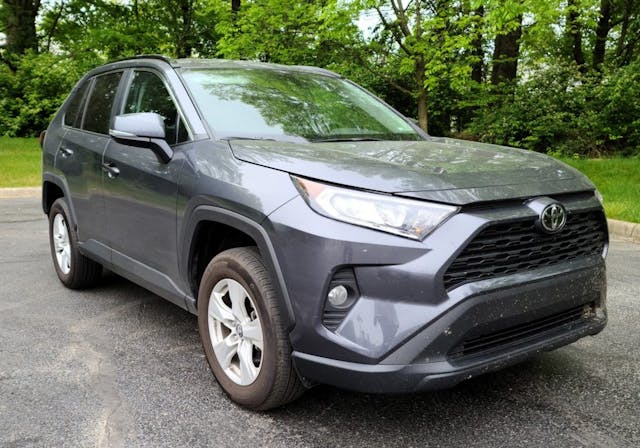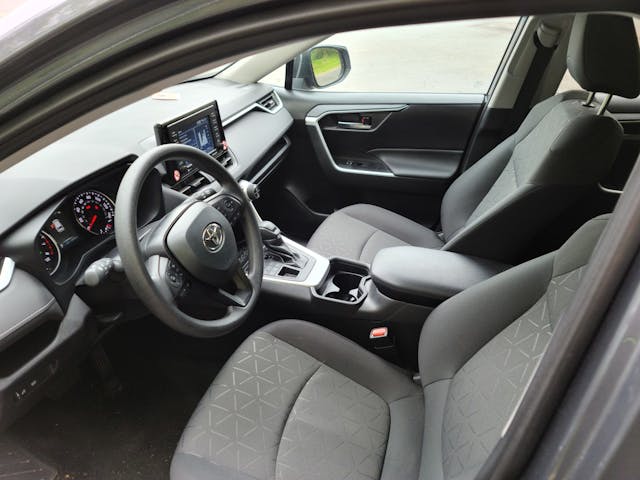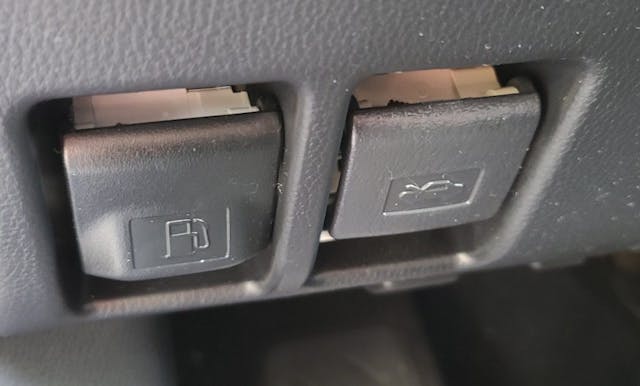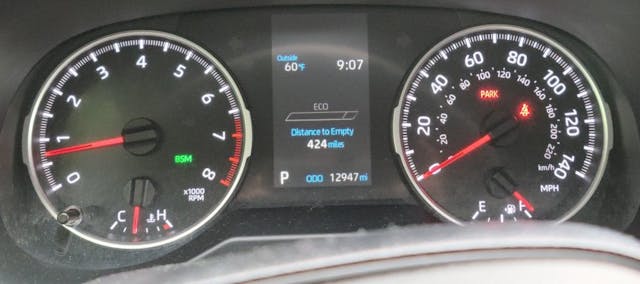Media | Articles
Review: 2021 Toyota RAV4 XLE AWD
About this time last year, we tested Toyota’s generic-wagon RAV4 in $41,418 TRD Pro trim. I drove it for about five days and thought it was just about the worst way you could spend $40K on a new car. It was slow, noisy, odd-looking, and about as cool as Mark Zuckerberg. I couldn’t figure out who would buy it, but I knew why Toyota gave it to us: because it was “the best one.” You see, the manufacturers want to make the best possible impression on the media, so they almost always provide a loaded-up version of whatever they’re trying to sell. This was true in 1980, when most cars had roll-up windows but press cars never seemed to suffer from them, and it’s true in 2021.
On a whim, and to see what the difference might be, I rented a $30,120 RAV4 and drove it … 2984 miles. In the course of five days. My findings are below.
What do you lose when you pare eleven grand off the price of your RAV4? Almost nothing a sane person would miss, and a few things he’d be happy to see go. The faux-butch interior and exterior styling disappears, as do the ridiculous high-rolling-resistance off-road wheels. The lousy leather interior is replaced by a serviceable cloth one. The leather touch points on the steering wheel and elsewhere disappear, replaced by the cheapest-feeling plastic imaginable, but you’re free to rectify that with an $1100 upgrade package if you really care.
The drivetrain is essentially the same: a 2.5-liter inline-four that produces 203 hp @ 6600 rpm and 184 lb-ft at 5000 rpm with absolutely zero charm, turning the front wheels all the time and the rear wheels some of the time via a conventional eight-speed automatic transmission. You still get several drive modes for the AWD system, but a few excursions on trails in the Ouachita National Forest suggested that it’s mostly window dressing; as Bob Dylan once sang, things come alive or they fall flat.
The alert reader will take note of just how unambitious this powertrain choice is. In an era defined by small displacements and tricky turbochargers, Toyota’s choice of a big-block four and a torque-converter automatic is oddly reminiscent of the company’s reluctance to ditch rear-wheel drive and traditional carburetors in the ’80s. Those of us who have observed Toyota for a long time know that it tends to exhibit this conservatism in market segments where the results really matter—and the RAV4 is now where the family-vehicle action is. This staid wagon, which has precisely nothing to do in concept or execution with the original funky-curvy surfer-focused RAV4 of decades past, regularly flirts with the half-million-mark in annual sales, putting clear air between itself and the competition both inside and outside the Toyota showroom.
Marketplace
Buy and sell classics with confidence
Perhaps as a consequence of this attitude, the RAV4 feels deliberately anachronistic compared not just to the bleeding-edgers like Ford and Hyundai but also when evaluated against Honda and GM. To sit in a new RAV4 is to be in a world where the astounding arms race for popular-price interior quality simply never occurred; it’s a soldier hiding in an Iwo Jima cave where people don’t balk at things like having the fuel door and hood operated by two crappy-feeling, crookedly installed, cheap plastic pull handles at the bottom of the dashboard, about where you’d find the parking-brake release on an ’84 Chevy truck. Oh, and they’re right next to each other in addition to being identical-looking, so about a third of the time you’ll pop the hood instead of the fuel door. Once you open the fuel door, there’s a cap to unwind. EasyFill? Never heard of him.
The steering wheel wouldn’t raise eyebrows on a first-generation Hyundai Accent. The stereo is astoundingly bad; listening to Grant Green’s landmark recording of “Down Here On The Ground,” the guitar is almost entirely absent, as if somebody at Toyota fancied themselves the next Bob Clearmountain, but in reverse. The door trims feel designed to irritate skin. Also, the interior seems to be no particular color, perhaps because it is comprised of several grays that might be intended to be the same, but maybe not. Nothing about this car will make you feel special. There will never be a day when you congratulate yourself on the purchase of such a compelling machine. If there’s a center to the universe of automotive fascination, you’re on the planet it’s farthest from.
And yet … over the course of several days’ constant driving, three of which exceeded 700 miles, this ugly, squat, nothing-special slug of a car just … works. It returns about 32 mpg at 85 mph, handles everything from service roads to blinding rain with considerable aplomb, and never feels unequal to the task at hand. The front and rear seats are spacious, reasonably supportive, and impervious to any damage from say, a bicycle chainwheel jammed into them by accident. The cargo area is nicely square, fully usable, low-floored, covered in plastics that resist scratching in much the same way that the plastics in a Honda CR-V do not.
The infotainment is not perfect, but it works well enough. There’s usable storage space everywhere you look. Visibility is a little better than what you normally get in this class, particularly to the rear three-quarter views. Headlights are decently bright, wipers are fast, all the primary controls click with authority and fail to wobble even under provocation.
Nobody will ever think the RAV4 XLE is fast but in most situations it feels more than equal to the task. Hills don’t bother it. The radar cruise control is among the best in the business and never panic-stops your face into your Buc-ee’s cup. Even the steering feel is remarkably decent on the unambitious rolling stock supplied on XLE trims; it’s bad on the TRD Pro but apparently that’s down to the Trophy Truck tires.
Because it’s a Toyota, and because it’s the least complex Toyota you can get short of a base Corolla, you know it’s going to last a very long time with very little in the way of unexpected expenses. You know that the purchase experience is likely to be a hassle but that’s okay because you won’t see the dealer very often after that; in this regard, it is the precise opposite of what your humble author experienced with every Land Rover he has ever purchased from his sublime and thoughtful local shop. Unlike with many domestic products, there is really no odometer reading at which a RAV4 will become worthless; if you run it for 300K and sandblast the immensely unimpressive paint off all four fenders you’ll still have people begging to buy it from you the afternoon it pops up on Craigslist.
Every era of humanity since the very first (1971, since that’s when I was born and the simulation started, obviously) has had a Toyota that exemplified what people wanted at that precise time. For a while, it was the RWD Corolla, then it was the Truck (don’t say HiLux, we’re not English) then it was the CALTY-styled Celica ST, then it was the 1995 Camry, then it was the Prius, then it was the Sequoia … and now it’s this. John Mayer called the present day “The Age Of Worry,” and that was before we all learned what “aerosolized” and “gain-of-function” meant. So this is a Toyota for the times, and the people, who worry. It is also a good car in which to spend three thousand miles. And a good car in which to spend three hundred thousand miles. It’s not for the enthusiast, but it deserves your grudging respect. Know someone who hates cars almost as much as she needs a car? Suggest the RAV4 in XLE trim. This may not be “the best one” Toyota makes … but it’s the best one, if you know what I mean.
2021 Toyota RAV4 XLE AWD
Price: $30,120 (as tested)
Pros: Everything you need …
Cons: … and nothing you want.
Summary: A modern take on the 1979 Chevrolet Malibu Estate Wagon, with all that entails.














